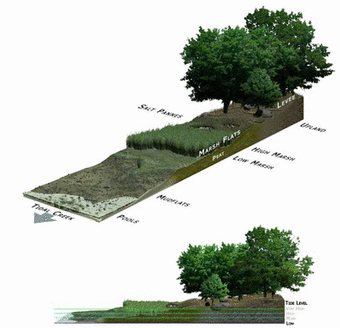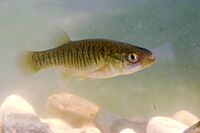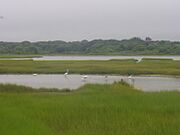Salt pannes and pools facts for kids

Salt pannes and pools are special watery spots found in salt marshes and brackish (slightly salty) marshes. Imagine a marsh as a big, grassy area near the coast that gets flooded by the ocean. Within these marshes, pannes and pools are like small puddles or ponds. Pools usually hold water for longer, especially in summer, even between high tides. Pannes, on the other hand, often dry out. These unique areas are home to many interesting plants and animals adapted to salty conditions.
Contents
What Are Salt Pannes and Pools?
Salt pannes and pools are low areas or hollows in salt marshes that hold water. They are important parts of these coastal environments. While they might look like simple puddles, they are actually tiny ecosystems with their own special conditions.
How Do Salt Pannes Form?
Salt pannes often start when a mat of dead plants and other natural bits, called wrack, lands on top of existing marsh plants. This wrack can smother and kill the plants underneath. When the plants die, it creates a small dip in the ground. This dip then collects water when the tide comes in. As the water repeatedly floods and then dries out, the panne becomes saltier than the surrounding ocean water. This high saltiness decides which types of plants and animals can live there.
Salt pools also form in marshes, but scientists are still learning exactly how they all begin. Some experts think that as sea levels go up, we might see more and larger salt pools in the future.
Why Are These Tiny Habitats Special?
Salt pannes and pools are unique microhabitats, meaning they are very small, special places for living things. They are home to various halophytes (salt-loving plants), plants that grow on the bottom of the water, and different kinds of sea creatures that live where rivers meet the sea. The mix of life in each panne or pool can change a lot because of several things:
What Affects These Tiny Habitats?
- Ground Type: The kind of soil or mud at the bottom affects how well the panne or pool can hold water.
- Size and Depth: How deep and wide a pool is changes its water temperature and how fast the water evaporates. A wide, shallow pool will dry out faster than a deep, narrow one with the same amount of water. Faster evaporation means the water becomes even saltier, sometimes a third saltier than regular ocean water!
- Location in the Marsh: Where a panne or pool is located within the intertidal zone (the area between high and low tide) also matters. If it's in the higher part of the marsh or further from the main water body, it might not get refilled by the tide as often, leading to more drying and higher saltiness.
These factors all work together to decide which plants and animals can survive and thrive in each specific salt panne or pool.
Exploring Different Kinds of Salt Pannes and Pools
Salt marshes have different types of pannes and pools, each with its own unique features and inhabitants.
Low Salt Marsh Pannes
These pannes are found in the lower parts of the salt marsh, closer to the main water body.
- Low Salt Marsh Pannes: These areas often have no plants growing in them. If plants are present, you might see smooth cordgrass (Spartina alterniflora) or marine algae like knotted wrack (Ascophyllum nodosum) and rockweeds (Fucus spp.). The ground here is usually soft, silty mud.
High Salt Marsh Pannes
These pannes are located in the higher parts of the salt marsh, which are flooded less often.
Arrow-Grass Pannes
- Arrow-Grass (Forb) Pannes: These are very shallow and get flooded only for a short time. They usually have a moderate amount of plants, mostly arrow-grass (Triglochin maritimum). The deepest parts might not have any plants at all.
Short Cordgrass Pannes
- Smooth Cordgrass (Short Form) Pannes: These are shallow dips where the water doesn't drain well. The ground here can be anaerobic (meaning it lacks oxygen), and the water might have low nutrients and high levels of certain chemicals called sulfides. These conditions make it hard for most plants to grow. However, a shorter version of smooth cordgrass (Spartina alterniflora), usually 6-12 inches tall, is the main plant found here. These pannes are typically in the high salt marsh but can sometimes be seen at the edges of the low salt marsh.
Salt Marsh Mosquito Pannes and Their Life Cycle

- Salt Marsh Mosquito Pannes: These pannes often have very few plants and are usually found in the upper half of the high salt marsh. They are typically deeper than the arrow-grass and short cordgrass pannes. They usually fill with water during the higher spring tides and can hold water for 2–3 weeks before drying out. When the surface is exposed and dry, the female eastern salt marsh mosquito (Aedes sollicitans) lays her eggs there. The eggs wait, dormant, until the next time the panne floods, and then they hatch, starting their life cycle.
Deepwater Pools: Home to Fish
- Widgeon Grass - Marsh Minnow Deepwater Pools: These pools are found in the high salt marsh and are either semi-permanently or permanently flooded. Because they hold water for a long time, they can support populations of small fish like the sheephead minnow (Cyprinodon variegatus variegatus) and the mummichog (Fundulus heteroclitus). These fish might get trapped in the pools. You can also find plants that grow on the bottom of these pools. Sometimes, these deepwater pools can be found at the upper edge of the low salt marsh.
Brackish Water Marsh Pannes

Brackish marshes are areas where fresh river water mixes with salty ocean water, creating a slightly salty environment. Pannes in these marshes have their own special plant communities.
Mixed Plant Pannes
- Mixed Graminoid - Forb Pannes: These are shallow dips that are flooded only for a short time. They are known for having a mix of grass-like plants and non-grassy plants. Common plants include three-square rush (Scirpus pungens), stout bulrush (S. robustus), arrow-grass, marsh creeping bent-grass (Agrostis stolonifera), and salt-loving spike-rush (Eleocharis halophila). Less common plants here are red fescue (Festuca rubra), New York aster (Symphyotrichum novi-belgii), silverweed, saltmeadow cordgrass (Spartina patens), and salt marsh rush.
Shaded, Sparsely Vegetated Pannes
- Sparsely Vegetated Pannes: These pannes are saturated with water and dominated by mud. They are sometimes found in the area where the marsh meets forested uplands. Overhanging tree branches shade these pannes, which helps prevent the water from evaporating too quickly. This shaded environment is a favorite spot for the uncommon seaside crowfoot (Ranunculus cymbalaria), which can form small, flat-growing groups over the soil. Other grass-like and non-grassy plants are scattered across the mud or, more often, around the edges of the panne. These include Virginia wild rye (Elymus virginicus), chaffy salt sedge (Carex paleacea), seaside goldenrod (Solidago sempervirens), marsh creeping bent grass, New York aster, and smooth cordgrass.


